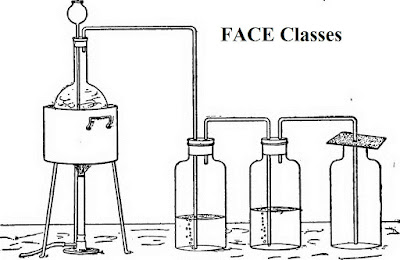Educational My YouTube Channel
By :- FACE Classes
Chemical Equation and Reaction,
For Class 10
Important Questions & Answer
 |
| Assignment chemical equation & Reaction |
1-Mark Questions/ Answers
1.
What happens when magnesium ribbon
burns in air?
Ans.
When magnesium ribbon burns in air, it
combines with the oxygen to form magnesium oxide.
2Mg(s) + O2(g) ® 2MgO(s)
2. Name the gas evolved when zinc reacts
with dil. HCl.
Ans. Hydrogen gas is evolved.
3.
What is a chemical equation?
Ans.
A chemical equation is a symbolic
notation that uses formulae instead of words to represent a chemical equation.
4.
On what chemical law, balancing of
chemical equation is based?
Ans.
Balancing of a chemical equation is based
on the law of conservation of mass.
5.
Represent decomposition of ferrous
sulphate with the help of balanced chemical equation.
Ans. 2FeSO4(s) ® Fe2O3(s)
+ SO2(g) + SO3(g)
6. When carbon dioxide is passed through
lime water, it turns milky, why?
Ans.
Lime water (calcium hydroxide) combines
with carbon dioxide to form a suspension of calcium carbonate which makes lime
water milky. Ca(OH)2 + CO2 ® CaCO3 +
H2O
7.
A zinc rod is left for nearly 20
minutes in a copper sulphate solution. What change would you observe
in zinc rod?
Ans.
Zinc rod will change into zinc sulphate.
8.
What type of reaction is this:
Na2SO4 + BaCl2 ® BaSO4
+ 2NaCl
Ans.
It is a double displacement reaction.
9.
Identify the compound oxidized in the
following reaction.
H2S (g) + Cl2 ® S(s) + 2HCl
(g)
Ans.
H2S is oxidized.
10.
What is rust?
Ans.
Rust is mainly hydrated iron (III) oxide, Fe2O3.xH2O.
11.
How does the food become rancid?
Ans.
Food becomes rancid when fat and oils
present in the food are oxidized.
2-marks Questions/ Answers
Q.1.
An iron knife kept dipped in a blue copper sulphate solution turns
the blue solution light green. Why?
Ans.
As we know iron is more reactive than
copper. So, it displaces Cu from CuSO4 solution and
forms ferrous sulphate which is of Light Green Colour.
CuSO4 (aq) + Fe (s)
→ FeSO4(aq)
+
Cu(s)
Blue colour
light
green colour
Q.2.
A copper coin is kept in
a solution of silver nitrate for some time. What will happen to the
coin and the colour of the solution?
Ans.
We know that copper is more reactive than
silver, so it will displace silver from its salt solution:
Cu(s)
+ 2AgNO3(aq)
→ Cu(NO3)2(aq)
+ 2Ag(s)
So the solution will turn blue
due to the formation of copper nitrate.
Q.3.
What do you understand by precipitation reaction? Explain with suitable examples.
Ans.
Precipitate. When two
reactants react and product formed remains insoluble and settles as a solid it
is called a precipitate. Such reactions in which precipitate is formed are
called precipitation reactions. For example,(i) when aqueous solution of
sodium sulphate is mixed with the aqueoussolution or barium chloride, barium sulphate
comes in the form of white precipitate
Na2SO4(aq)
+ BaCl2(aq)
→ BaSO4(↓)
+ 2NaCl(aq)
(ii)
When aqueous solution of
sodium chloride is mixed with the aqueous solution of silver
nitrate, silver chloride comes in the form of white precipitate.
Q.4.
What is lime-water test for the detection
of carbon dioxide?
Ans.
When carbon dioxide gas is passed through
lime water ,it turns milky due to the formation of milky suspension
(precipitate) of calcium carbonate. Carbon dioxide is produced by the action of
dilute HCl on sodium carbonate.
Na2CO3(s) + 2HCl(aq)
→
2NaCl + H2O(l)
+ CO2
Carbon
dioxide gas produced in this reaction is passed through lime water that changes
to milky colour due to the formation of calcium carbonate.
Ca(OH)2(aq)
+ CO2(g)
→
CaCO3 +
CO2(g)
3 Marks Questions/ Answers
Q.5.
What is corrosion? State the
conditions necessary for rusting of iron. How rusting is harmful?
Ans:
Corrosion. The process of
eating away of the metal by the action of atmospheric reagents changing the
metal into its compound is called corrosion.
Rusting
of Iron.
When iron and iron objects are exposed to atmosphere, they are attacked by air
and moisture (water) of the atmosphere and a brown and orange coloured layer is
formed on the surface. It is called rust which is mainly hydrated iron (iii)
oxide Fe2O3.xH2O.
Harmful
Effect of Rusting.
Hydrated iron (iii) oxide is brittle substance and moves away from the surface
thus the object is damaged. The objects get holes, cavities and rough surface.
Conditions necessary for rusting :
(i)
Open surfaces of the metal. (ii) Presence of air (Oxygen).
(iii)
Presence of moisture (water).
Q.6.
What is rancidity? Write the common method to
prevent it.
Ans.
When food item are kept unprotected for
some time, they give some unpleasant smell and taste and become rancid. This
process is called rancidity. Actually, the micro organisms oxidise the fat and
oils present in them. So oxidation of food items need to be prevented to
protect them.
Common methods to Prevent Rancidity of Food
item:
(i) Keeping the food at low temperature
(ii) Keeping food item in air tight
containers
(iii) By filling nitrogen in the food
storage bags.
5 Marks Questions/ Answers
1.
a. Why
cannot a chemical change be normally reversed?
b. why
is it always essential to balance a chemical equation?
c.
what happens when CO2 gas
is passed through lime water and why does it disappear on passing excess CO2?
d. Can
rusting of iron takes place in distilled water?
Ans:
a. In a chemical change some bonds
are broken and some bonds are formed. The products are quite different from the
reactants. Therefore it normally can’t be reversed.
b. A chemical equation has to be balanced to
satisfy the law of conservation of mass.
c.
On passing CO2 gas
through lime water, it turns milky due to formation of insoluble calcium
carbonate which dissolves on passing excess CO2 due to formation of
soluble calcium bicarbonate.
Ca(OH)2
+ CO2(g) --------------→ CaCO3(s) + H2O(l)
CaCO3(s)
+ H2O(l) + CO2 (g) ---------------→ Ca(HCO3)2(soluble)
d.
No, rusting of iron cannot take
place in distilled water because it neither contains dissolved oxygen
nor CO2 both are essential for rusting of iron.
Hots Questions
Q
1 . The marble statues often slowly get
corroded when kept in open for a long time .Assign a suitable explanation
Ans- SO2,NO2 gases are
released into the atmosphere from various sources. These dissolve in rain water
to give acid which corrodes marble statues
2SO2+O2
--------------→ 2SO3
H2O+SO3
--------------→ H2SO4
2NO2+H2O 2HNO3
CaCO3+H2SO4--------------→ CaSO 4
+H2O+CO2
CaCO3+2HNO3
--------------→Ca(NO3)2+H2O+CO2
Q
2. You are given the following materials
(1)
marble chips (2)dilute hydrochloric acid (3)Zinc granules ,identify the type of
reaction when marble chips and Zinc granules are added separately to acid taken
in two test tubes
Ans- (i) marble
chips react with dilute hydrochloric acid to form calcium chloride and carbon
dioxide .it is a double displacement reaction
CaCO3+2HCl
→ CaCl2 + H2O +CO2
(ii) Zinc
granules react with dilute hydrochloric acid to give hydrogen g as. it is a displacement reaction
Zn(s)+2HCl
→ ZnCl2(aq)+H2(g)
Q3.
The gases hydrogen & chlorine do not
react with each other even if kept together for a long time . However , in the
presence of sunlight , they readily combine . What does actually happen ?
Ans- In Chemical reactions , energy is needed to
break the bonds present in the reacting molecules so that they may combine to
form the products . In this reaction , sunlight is the source of energy in the
form of photons . The energy made available by sunlight helps in breaking the
bonds & this leads to chemical reaction between hydrogen & chlorine.
H2 (g) + Cl2(g)
sunlight→ 2HCl (g)
Q
4. A,B&C are three elements which
undergo chemical reactions in the following way
A2O3 + 2B®B2O3
+ 2A
3CSO4 + 2B -® B2(SO4)3
+
3C
3CO+ 2A ®A2O3 +3C
Answer the following
(A) Which
element is most reactive ?
(B) Which
element is least reactive ?
Ans:
a) The most reactive
element is ‘B’. It has displaced both ‘A’ and ‘C’ from their compounds.
b)
The least reactive element is ‘C’ as it has been displaced by both ‘A’ and ‘B’
.
Q.
A water insoluble substance ‗X‘ on
reacting with dilute H2SO4 released a colourless and
odourless gas accompanied by brisk effervescence. When the gas was
passed through water , thesolution obtained turn blue litmus red . On
bubbling the gas through lime water , it initially became milky and the
milkiness disappeared when the gas was passed in excess . Identify the
substance ‗X‘ and write the chemical equations of the reaction involved
Ans:
The water insoluble substance ‘X’ is most
probably metal carbonate
( CaCO3 ). The chemical reaction
that involved are given below
CaCO3 (s) + H2SO4
(aq) →CaSO4 ( aq) + H2O (aq) + CO2 (g)
Ca(OH)2 (s) + CO2 (g)
→ CaCO3 (s) ( milky) + H2O (l)
CaCO3 (s) + CO2 (g) +
H2O (aq) →Ca(HCO3)2 (
milkiness)
 |
| chemical Reaction and Equation |
Extra score questions:
Q
1. If you collect silver coins and
copper coins. After some day a black coating on silver coins and a green
coating on copper coins. Which chemical phenomenon is responsible for these
coatings? Write the chemical name of black and green coatings
Ans:
Corrosion is responsible for this
coating. Black coating is due to formation of Ag2S and green coating
is due to formation of CuCO3. Cu(OH)2
Q.2.
An aqueous solution of metal nitrate P
reacts with sodium bromide solution to form yellow ppt of compound Q which is
used in photography. Q on exposure to sunlight undergoes decomposition reaction
to form metal present in P along with reddish brown gas. Identify P&Q .
Write the chemical reaction & type of chemical reaction.
Ans:
P = AgNO3 , Q = AgBr
2 AgBr (s) ® 2Ag(s) + B r2(g)
Photochemical decomposition
Q.3.
A substance X used for coating iron
articles is added to a blue solution of a reddish brown metal Y, the color of
the solution gets discharged Identify X and Y & also the type of reaction.
Ans.
6 X= Fe, Y = Cu, Displacement reaction.
Q.4.
A student burnt a metal A found in the
form of ribbon. The ribbon burnt with a dazzling flame & a white powder B
is formed which is basic in nature. Identify A &B. Write the balanced
chemical equation.
Ans. 11 X = Mg, Y = MgO,
Mg + O2® 2
MgO
Q.5.
Why magnesium ribbon cleaned before
burning?
Ans:
The magnesium ribbon is always found with
a white layer of MgO due attack of moist air. So, magnesium ribbon
cleaned before burning.
Q.6.
During electrolysis of water gas
collected in one test tube is double than other why?
Ans: On electrolysis water decompose into
hydrogen and oxygen in ratio 2:1 by volume so,H2 gas collected
in one test tube is double than O2





Jio
ReplyDeleteSir,would you like to tell us about some examples of displacement reaction in which hydrogen and oxygen gas is not involved?
ReplyDelete